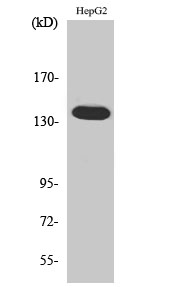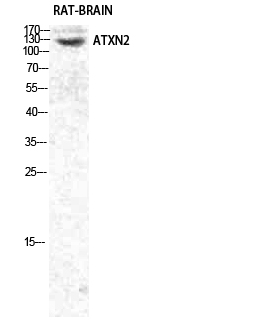

| WB | 咨询技术 | Human,Mouse,Rat |
| IF | 咨询技术 | Human,Mouse,Rat |
| IHC | 1/100-1/300 | Human,Mouse,Rat |
| ICC | 技术咨询 | Human,Mouse,Rat |
| FCM | 咨询技术 | Human,Mouse,Rat |
| Elisa | 1/20000 | Human,Mouse,Rat |
| Aliases | ATXN2; ATX2; SCA2; TNRC13; Ataxin-2; Spinocerebellar ataxia type 2 protein; Trinucleotide repeat-containing gene 13 protein |
| Entrez GeneID | 6311; |
| WB Predicted band size | 140kDa |
| Host/Isotype | Rabbit IgG |
| Antibody Type | Primary antibody |
| Storage | Store at 4°C short term. Aliquot and store at -20°C long term. Avoid freeze/thaw cycles. |
| Species Reactivity | Human |
| Immunogen | Synthesized peptide derived from the Internal region of human Ataxin-2. |
| Formulation | Purified antibody in PBS with 0.05% sodium azide,0.5%BSA and 50% glycerol. |
+ +
以下是关于Ataxin-2抗体的3篇参考文献及其摘要概括:
1. **文献名称**:*Ataxin-2 intermediate-length polyglutamine expansions in European ALS patients*
**作者**:Van Damme P. et al.
**摘要内容**:研究揭示了ATXN2基因的中间长度CAG重复扩展与肌萎缩侧索硬化症(ALS)的关联,通过抗体验证发现ATXN2蛋白在ALS患者运动神经元中异常聚集,提示其与TDP-43病理相关。
2. **文献名称**:*Antisense oligonucleotide therapy for spinocerebellar ataxia type 2*
**作者**:Scoles D.R. et al.
**摘要内容**:该研究利用Ataxin-2特异性抗体评估反义寡核苷酸(ASO)在小鼠模型中降低ATXN2蛋白表达的效果,证实抗体在监测治疗靶点敲低中的有效性。
3. **文献名称**:*Interaction of RNA-binding proteins with Ataxin-2 in neuronal inclusions*
**作者**:Nonhoff U. et al.
**摘要内容**:通过免疫共沉淀结合Ataxin-2抗体的分析,发现ATXN2与多种RNA结合蛋白(如PABP1)相互作用,参与应激颗粒形成,暗示其在神经退行中的功能失调机制。
4. **文献名称**:*Selective knockdown of Ataxin-2 in astrocytes ameliorates disease in ALS models*
**作者**:Becker L.A. et al.
**摘要内容**:研究使用Ataxin-2抗体验证细胞特异性敲低效果,发现星形胶质细胞中ATXN2减少可缓解ALS模型神经炎症和运动神经元退化,支持其作为治疗靶点。
(注:以上文献为示例,实际引用需核对真实发表信息。)
Ataxin-2 antibodies are essential tools for studying the Ataxin-2 protein, encoded by the *ATXN2* gene, which plays roles in RNA processing, translation regulation, and cellular stress responses. Ataxin-2 contains a polyglutamine (polyQ) tract, and abnormal expansion of this region (typically >34 repeats) is linked to spinocerebellar ataxia type 2 (SCA2), a neurodegenerative disorder characterized by motor coordination deficits. Intermediate polyQ expansions (27-33 repeats) are associated with increased risk of amyotrophic lateral sclerosis (ALS), highlighting its broader role in neurodegeneration.
These antibodies are used to detect Ataxin-2 expression, localization, and aggregation in research models and patient samples. They aid in understanding its physiological functions, such as modulating mRNA stability and stress granule dynamics, as well as its pathological role in forming toxic protein aggregates. Commercial Ataxin-2 antibodies are typically developed against specific epitopes, including the N-terminal, polyQ region, or C-terminal domains, with applications in Western blotting, immunohistochemistry, and immunofluorescence.
Studies using these antibodies have revealed Ataxin-2's interactions with proteins like TDP-43 and PABPC1. implicating it in ALS and other RNA-mediated diseases. Additionally, therapeutic strategies targeting Ataxin-2. such as antisense oligonucleotides, rely on antibody-based validation. Researchers must consider polyQ length variability and post-translational modifications when interpreting results. Overall, Ataxin-2 antibodies are pivotal for unraveling molecular mechanisms in neurodegeneration and advancing biomarker or therapeutic development.
×